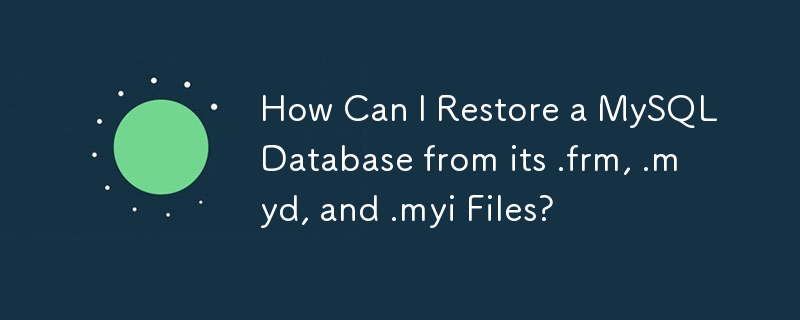Found a total of 10000 related content

How to Store and Display Unicode (Hindi) Strings in PHP and MySQL?
Article Introduction:Resolving encoding issues for storing and displaying Hindi text (Unicode) in PHP and MySQL databases, involving proper MySQL database configuration, using UTF-8 encoding for table fields, and applying encoding for retrieval and display using PHP.
2024-10-23
comment 0
288


How do you optimize database schema design for performance in MySQL?
Article Introduction:Optimizing database schema design in MySQL can improve performance through the following steps: 1. Index optimization: Create indexes on common query columns, balancing the overhead of query and inserting updates. 2. Table structure optimization: Reduce data redundancy through normalization or anti-normalization and improve access efficiency. 3. Data type selection: Use appropriate data types, such as INT instead of VARCHAR, to reduce storage space. 4. Partitioning and sub-table: For large data volumes, use partitioning and sub-table to disperse data to improve query and maintenance efficiency.
2025-04-30
comment 0
759

How to Retrieve and Display Database Data in PHP/HTML Tables?
Article Introduction:This article presents a code example in PHP to connect to a MySQL database, execute a query to retrieve data from a "employee" table, and display the results in an HTML table. It highlights the use of PHP functions for database connection a
2024-10-25
comment 0
879

How to Read MySQL Tables as Spark DataFrames?
Article Introduction:Integrating Apache Spark with MySQL for Database Table ReadingTo connect Apache Spark with MySQL and leverage database tables as Spark dataframes,...
2024-11-01
comment 0
360

mysql tutorial for creating a database and table
Article Introduction:The methods for creating databases and tables are as follows: 1. Use CREATEDATABASEdatabase_name; create databases, such as CREATEDATABASEschool; 2. Use IFNOTEXISTS to avoid repeated creation, such as CREATEDATABASEIFNOTEXISTSschool; 3. You can specify character sets, such as CREATEDATABASEschoolCHARACTERSETutf8mb4COLLATEutf8mb4_unicode_ci; 4. Use USEschool; switch to the target database; 5. Use CREATETABLE to build tables, such as CREA
2025-06-27
comment 0
796

How to Create a PHP/MySQL Powered Forum From Scratch
Article Introduction:This tutorial guides you through building a PHP/MySQL-powered forum from the ground up. It's ideal for beginners learning PHP and database interaction.
Step 1: Database Table Creation
Effective application development begins with a robust data model
2025-02-27
comment 0
827

How to Display SQL Database Data in a PHP/HTML Table?
Article Introduction:This article demonstrates a PHP script that displays data from a MySQL database in an HTML table. It covers connecting to the database, executing a query, retrieving data row by row, and generating HTML code for the table. The script includes securit
2024-10-24
comment 0
626

How to Check for Column Existence in MySQL?
Article Introduction:Checking for Column Existence in MySQL TablesVerifying the existence of a column in a MySQL table is crucial for database management and data...
2025-01-03
comment 0
1125

How to Display MySQL Database Data in a PHP/HTML Table?
Article Introduction:This article describes the steps to connect to a MySQL database, execute a query to retrieve data, and display the results in a PHP/HTML table. It provides a code example for connecting to the database, executing a query, generating the HTML table, a
2024-10-24
comment 0
1123

How do I create and manage databases and tables in MySQL?
Article Introduction:This article details MySQL database management, covering creation, management, optimization, and security. It explains SQL commands for database and table manipulation, query optimization techniques, and crucial security measures to protect data.
2025-03-11
comment 0
946

Is the syntax of adding columns in different database systems the same?
Article Introduction:The syntax for adding columns in different database systems varies greatly, and varies from database to database. For example: MySQL: ALTER TABLE users ADD COLUMN email VARCHAR(255); PostgreSQL: ALTER TABLE users ADD COLUMN email VARCHAR(255) NOT NULL UNIQUE;Oracle: ALTER TABLE users ADD email VARCHAR2(255);SQL Server: ALTER TABLE users ADD email VARCH
2025-04-09
comment 0
550



















